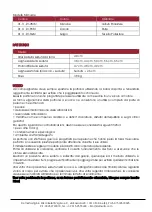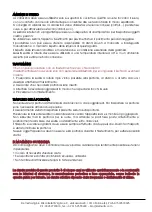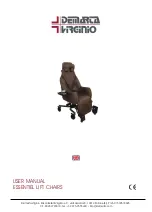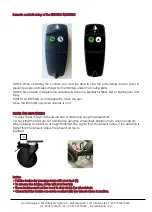
Demarta Virginio SAS di Belletti Virginio e C, via Bozzalla 20, 13814 Pollone (BI), P.IVA 01530570025,
C.F. 00459790010, Tel. +39 015-9555440
–
Electric Mode
Code
Color
Material
01.11.Z3-VME
Brown
Polyester Velvet
01.11.Z3-PCE
Cocoa
Leather
01.11.Z3-TGE
Grey
Polyester Fabric
Manual Mode
Code
Color
Material
01.11.Z3-VMM
Brown
Polyester Velvet
01.11.Z3-PCM
Cocoa
Leather
01.11.Z3-TGM
Grey
Polyester Fabric
TECHNICAL FEATURES
Dimensions
Seat height from the ground
48 cm
Seat width
38 cm, 44 cm, 50 cm, 56 cm, 65 cm
Seat depth
47 cm, 48 cm, 49 cm
Total width (ar seat)
Seat + 26 cm
Weight
38 Kg
USE
The attendant must always move the wheelchair by using the push bar and keeping it slightly
reclined to avoid the footrest to touch the ground.
These wheelchairs are not designed to be used as a seat in a motorised vehicle.
The ergonomic shape of the shell-framed wheelchair and its various accessories allow a full-scale
utilisation by people suffering from those following handicaps:
• paralysis
• weakness/malformation of articulations
• lesions of articulations
• diseases such as heart failure and circulatory deficiency, balance disorders or cachexia and
clinical geriatric signs
Concerning the contraindications, the following factors must be considered:
• weight over 130 kg
• physical and psychological condition
• inadequate living environment
The shell-framed wheelchair is designed for people who lost their muscular strength, therefore it is
necessary to be particularly vigilant during its utilization.
It is imperative to choose the model that is the most adapted to the patient’s body size.
Before using the wheelchair, verify the proper functioning of the jacks and the brakes, and make
sure the harness is fastened.
When a patient is being seated or lifted away from the shell, whatever method is being used, it is
imperative to engage the brakes, fold the leg rest vertically, and adjust the boards on the ground
to avoid any forward tilting.
Once the patient is seated in the shell, it is compulsory to buckle the body harness and adjust it
close to the body in order to avoid the patient to slide under the harness. Once the harness is
adjusted, the wheelchair must be tilted backwards to end the sliding effect.






































